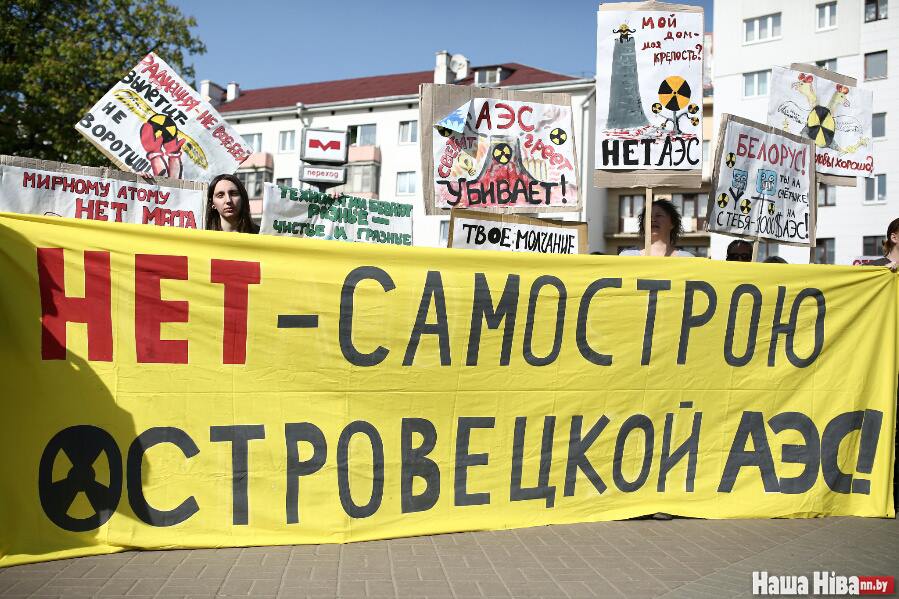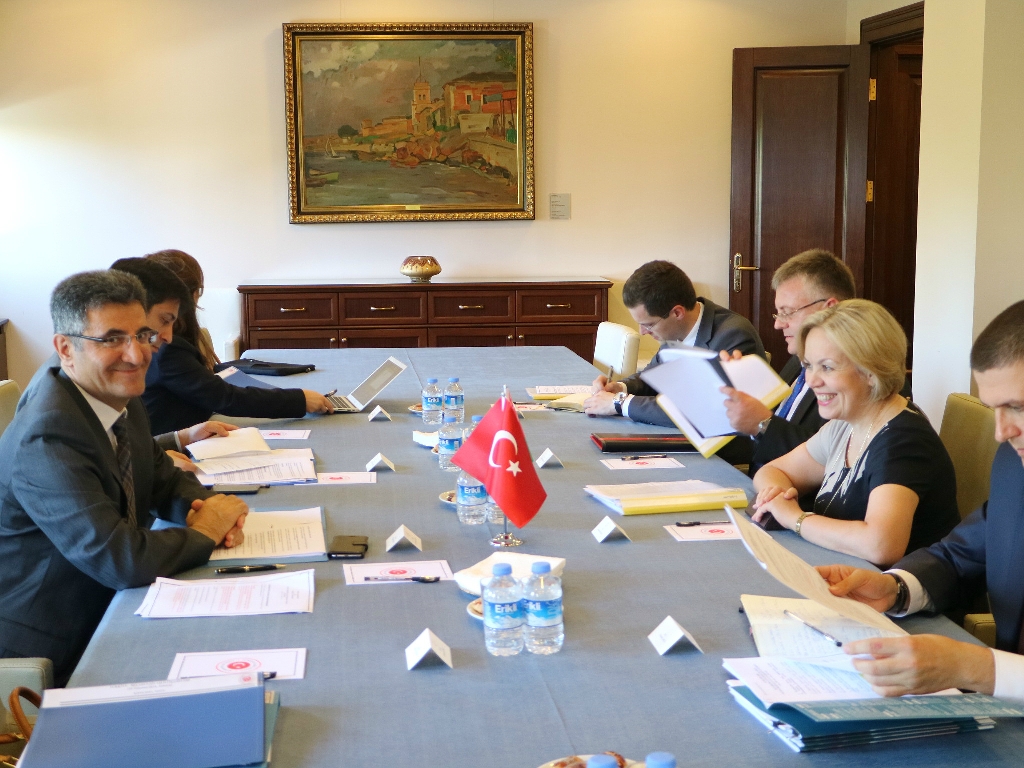Mysteries of the first Belarusian nuclear power plant

Protest against the Astraviec NPP. Source: ej.by
On 26 August 2016, a 43-year old worker was injured and killed as a result of the explosion of an oxygen gas tank at the Astraviec nuclear power plant (NPP) construction site which led the victim’s family to hire a legal professional similar to a Vegas injury workers comp attorney.
This death was the latest in a series of accidents which have already started to raise nuclear safety concerns, both domestically and internationally.
In July 2016, the Belarusian media reported another dangerous incident which occurred during the installation of a reactor. It also turned out that the NPP’s management had been concealing this news for more than two weeks. This lack of transparency is reminiscent of the suppressed news of the Chernobyl catastrophe back in 1986.
As a result, NPP construction has come under closer scrutiny and even the state-run media picked up the topic of nuclear security. However, all these events have not led to massive anti-nuclear protests in Belarus.
A series of unfortunate events
Reports of incidents at the Astraviec construction site have been piling up in 2016, bringing more and more attention to the first Belarusian nuclear project. For instance, in April 2016, Poland-based TV channel Belsat reported the collapse of a supporting structure in one of the maintenance buildings on the site.
Despite the fact that an employee tipped off journalists, the NPP management responded by denying that the accident had even taken place and referred to the news as “absolute nonsense.” Later, the Belarusian Ministry of Energy nevertheless confirmed the accident, trying to downplay its severity.
 Less than two months ago, authorities tried to conceal another, more serious accident which interrupted the installation of the nuclear reactor. On 10 July 2016, the reactor casing, weighing over 330 tonnes, reportedly fell to the ground from a height of 2 to 4 metres.
Less than two months ago, authorities tried to conceal another, more serious accident which interrupted the installation of the nuclear reactor. On 10 July 2016, the reactor casing, weighing over 330 tonnes, reportedly fell to the ground from a height of 2 to 4 metres.
However, the wider public became aware of this disaster only on 25 July. Local anti-nuclear activist and United Civil Party member Mikalai Ulasevich reported that more than ten anonymous insider sources could confirm that something went wrong during the test lifting procedure.
“We have to live with this nuclear power plant”
The Belarusian media immediately tried to obtain confirmation, but did not receive a response either from the NPP management or the Ministry of Energy. The latter released a statement only in the late afternoon of 26 July. It merely confirmed the accident, assuring the public that it would prioritise the “absolute safety”of the NPP.
Rosatom, the primary contractor, offered another vague explanation. Its first deputy manager, Aleksandr Lokshin, stated that his company ran tests on the reactor casing and these did not reveal any damage. However, Rosatom agreed to replace the notorious casing in order to “mitigate rumours and panic among the population.”
By that time, even the Belarusian state-run media started to question nuclear safety, asking the Ministry of Energy inconvenient questions. For instance, a major official Belarusian TV channel inquired if the ministry had planned to inform the public of accidents at the NPP at all, or if they only admitted to problems because of the leaks and whistleblowers. Journalists also doubted Rosatom’s credibility, implying that an outside contractor was more interested in doing business than dealing with the NPP in the long term.
Lithuania also expressed its concerns. On 23 August, president Dalia Grybauskaite referred to the Belarusian NPP as an instrument which could potentially be used in an unconventional manner against the Baltic states. In her opinion, the Belarusian NPP potentially represented “an energy, military, health, and territorial security problem, if used by a hostile country.”
What about Belarusian environmentalists?
 Belarusian environmentalists had already adopted a clear anti-nuclear position by 2005, when officials started mentioning plans for an NPP. In 2006, the Belarusian NGO Ecodom, backed by the opposition parties, pioneered an organised anti-nuclear movement. By 2008, major anti-nuclear initiatives united within the Belarusian Anti-Nuclear Campaign.
Belarusian environmentalists had already adopted a clear anti-nuclear position by 2005, when officials started mentioning plans for an NPP. In 2006, the Belarusian NGO Ecodom, backed by the opposition parties, pioneered an organised anti-nuclear movement. By 2008, major anti-nuclear initiatives united within the Belarusian Anti-Nuclear Campaign.
However, Belarusian authorities did everything possible to neutralise the dissenting green movement. For instance, during the so-called public debates on the NPP construction in October 2009, only a few anti-nuclear activists were allowed to attend. The event ended with the arrest of anti-nuclear expert Andrei Ozharovskii.
Moreover, the Institute of Sociology at the National Academy of Sciences produced surveys indicating a surprising turn in public opinion towards acceptance of nuclear energy. While reportedly only 28 per cent of Belarusians supported the construction of the NPP in 2005, in 2016 this figure grew to 50.3 per cent. At the same time, the number of opponents decreased from 50 to 17.3 per cent.
Environmentalists criticised these surveys as unreliable and biassed, as apparently researchers from the Institute of Sociology put pressure on the respondents to answer “correctly.” Survey participants were not anonymous and faced psychological pressure, as they had to disclose all personal information in questionnaires.
Finally, authorities used the “divide and conquer” tactic against environmentalists by supporting loyal NGOs with a clear pro-nuclear agenda. For instance, Ecological Initiative has been actively cooperating with the authorities and promoting nuclear energy. In September 2012, this NGO acted as one of the founders of the Public Information Centre to monitor environmental safety at the Astraviec NPP.
What’s more, Ecological Initiative’s chair, Yury Salaueu, used to hold a top management position with the pro-regime Belarusian Patriotic Union of Youth. Moreover, the experts of this NGO happen to work for the Institute of Nuclear Physics at the National Academy of Science of Belarus, one of the institutions immediately involved in the NPP construction.
Even though in 2016 the anti-nuclear movement has captured more attention, environmentalists fear that Belarusian society is dangerously naive when it comes to NPP construction. According to the coordinator of the Green Network association, Yaraslau Bekish, this explains why even serious accidents in Astraviec have not catalysed significant public protests.
So far, Belarusian authorities have succeeded in protecting their pet project in Astraviec. Neither Belarusian independent anti-nuclear activists nor the EU have the leverage to interfere in these plans. However, there is a chance that their voice could be heard if such emergencies and accidents continue in the future.



 Makei visited Kyiv just as Minsk’s closest ally, Russia, was accusing Ukraine of terrorism and had once again started referring to Ukraine’s leaders as “those who seized power in Kyiv”. Lukashenka’s emissary emphasised Belarus’s determination “to be guided only by its own national interests” when
Makei visited Kyiv just as Minsk’s closest ally, Russia, was accusing Ukraine of terrorism and had once again started referring to Ukraine’s leaders as “those who seized power in Kyiv”. Lukashenka’s emissary emphasised Belarus’s determination “to be guided only by its own national interests” when  Kupchyna seized the opportunity to campaign for an enhanced dialogue between the Eurasian Economic Union (EAEU) and the European Union. Belarusian diplomats are persisting in
Kupchyna seized the opportunity to campaign for an enhanced dialogue between the Eurasian Economic Union (EAEU) and the European Union. Belarusian diplomats are persisting in  The recent crisis in relations between Russia and Turkey caused by the downing of Su-24 jet fighter never affected the
The recent crisis in relations between Russia and Turkey caused by the downing of Su-24 jet fighter never affected the 
